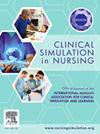The impact of high-fidelity simulation training on first-year nursing students’ attitudes toward communication skills learning: A quasi-experimental study
IF 3.4
3区 医学
Q1 NURSING
引用次数: 0
Abstract
Background
Communication skills are essential for fostering nurse-patient relationships and ensuring quality nursing care, making them a critical competency in nursing education. Attitudes constitute powerful behavioral indicators and influence the learning process of nursing students.
Aim
This study evaluated the effects of high-fidelity simulation training on first-year nursing students' attitudes toward learning communication skills.
Methods
A total of 149 first-year students participated in a quasi-experimental study, in which their attitudes toward learning communication skills were compared between baseline and after the simulation experience. The standardized patient performed different behaviors during each simulated nursing consultation: assertive, passive/noncompliant, depressed, aggressive, and agitated.
Results
Nursing students significantly improved their attitudes toward learning communication skills after the simulation sessions.
Conclusion
High-fidelity simulation training using standardized patients allows first-year nursing students to improve their attitudes toward learning communication skills. This improvement can provide benefits directly related to nurse-patient relationships and high-quality nursing care. Therefore, the inclusion of simulation training programs in nursing curricula is necessary to promote these attitudes in order to prepare undergraduate nursing students for real clinical practice.
求助全文
约1分钟内获得全文
求助全文
来源期刊

Clinical Simulation in Nursing
NURSING-
CiteScore
5.50
自引率
15.40%
发文量
107
期刊介绍:
Clinical Simulation in Nursing is an international, peer reviewed journal published online monthly. Clinical Simulation in Nursing is the official journal of the International Nursing Association for Clinical Simulation & Learning (INACSL) and reflects its mission to advance the science of healthcare simulation.
We will review and accept articles from other health provider disciplines, if they are determined to be of interest to our readership. The journal accepts manuscripts meeting one or more of the following criteria:
Research articles and literature reviews (e.g. systematic, scoping, umbrella, integrative, etc.) about simulation
Innovative teaching/learning strategies using simulation
Articles updating guidelines, regulations, and legislative policies that impact simulation
Leadership for simulation
Simulation operations
Clinical and academic uses of simulation.
 求助内容:
求助内容: 应助结果提醒方式:
应助结果提醒方式:


